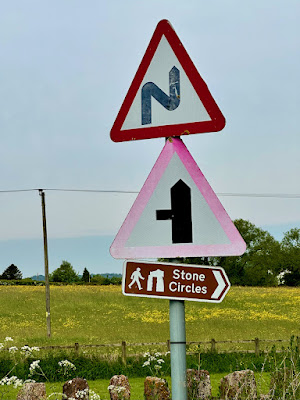The work of a rock is to ponder whatever is:
an act that looks singly like prayer,
but is not prayer.
As for this boulder,
its meditations are slow but complete.
Someday, its thinking worn out, it will be
carried away by an ant.
an act that looks singly like prayer,
but is not prayer.
As for this boulder,
its meditations are slow but complete.
Someday, its thinking worn out, it will be
carried away by an ant.
— Jane Hirshfield, from her poem Rock

One one of the wonders, and perplexities, of megalithic Britain.
— Aubrey Burl on Stanton Drew Stone Circles, Chew Magna
Contemplating Jeffrey Cohen’s words:
To
narrate the past conjures possible futures. Stone challenges small,
linear divisions of human history through its aeonic insistence. The
lithic thickens time into multiple, densely sedimented, and combustively
coincident temporalities. Its inhuman scale summons geologic
contemplation, extension of story far beyond accustomed durations.
… To touch stone is to encounter alien duration. Drawing by William Stukeley, the leading
antiquarian of the 18th century:
1723.
July. 23rd. Stanton Drew. Somerset.
The Cove stones and the Church of
St Mary the Virgin.
The three Cove stones, remnants of a Neolithic chambered tomb, dolomitic breccia (Triassic) transported from a different source and placed 1000 years before the three late-Neolithic stone circles on
the Chew River plain to the northeast of the church.
Today,
The Cove stones are encompassed by the garden of the Druid's Arms pub. So it became
in May this year we strolled and stared our way in and around the Stanton Drew Stone Circles before partaking of a pint of local cask ale in this congenial
garden. While the Stones in patient confidence took measure of their
imbibing and transient visitors. One of many rituals witnessed through timeless
seasons. NOTES
— Stukeley Festival at Stanton Drew, a celebration on July 22-23 2023 of the 300th anniversary of the visit of the celebrated antiquarian, William Stukeley.
— Stukeley Festival at Stanton Drew, a celebration on July 22-23 2023 of the 300th anniversary of the visit of the celebrated antiquarian, William Stukeley.
— Stanton Drew is the site of the most important stone
circles in England, after Stonehenge and Avebury. There are three
circles, of which the Great Circle is second only to Avebury in size,
and a cove of three stones in the village.
— Stanton Drew 2010: Geophysical survey and other archaeological investigations. Scroll down page to download PDF of this recent study.
—
Aubrey Burl, who died in 2020 aged 93, published around 30 books about
prehistoric standing stones of north-west Europe. See: A Guide to the
Stone Circles of Britain, Ireland and Brittany (2005, Yale) with some
pages devoted to Stanton Drew.
— Jane Hirshfield, from the poem Rock in Given Sugar, Given Salt (2001 Harper).
— Jeffery Jerome Cohen. Stone: The Ecology of the Inhuman (2015 U Minn Press) pp 78, 80.
— Michelle Beauchamp. Sacred Places, Storied Places: Ancient Wisdom for a Modern World. 2013. University of Victoria. Finding the Way, with Spirit!
— Jane Hirshfield, from the poem Rock in Given Sugar, Given Salt (2001 Harper).
— Jeffery Jerome Cohen. Stone: The Ecology of the Inhuman (2015 U Minn Press) pp 78, 80.
— Michelle Beauchamp. Sacred Places, Storied Places: Ancient Wisdom for a Modern World. 2013. University of Victoria. Finding the Way, with Spirit!
Rock
What appears to be stubbornness,
refusal, or interruption,
is to it a simple privacy. It broods
its one thought like a quail her clutch of eggs.
Mosses and lichens
listen outside the locked door.
Stars turn the length of one winter, then the next.
Rocks fill their own shadows without hesitation,
and do not question silence,
however long.
Nor are they discomforted by cold, by rain, by heat.
The work of a rock is to ponder whatever is:
an act that looks singly like prayer,
but is not prayer.
As for this boulder,
its meditations are slow but complete.
Someday, its thinking worn out, it will be
carried away by an ant.
A Mystrium camillae,
perhaps, caught in some equally diligent,
equally single pursuit of a thought of her own.
— Jane Hirshfield, in Given Sugar, Given Salt (2001 Harper)
What appears to be stubbornness,
refusal, or interruption,
is to it a simple privacy. It broods
its one thought like a quail her clutch of eggs.
Mosses and lichens
listen outside the locked door.
Stars turn the length of one winter, then the next.
Rocks fill their own shadows without hesitation,
and do not question silence,
however long.
Nor are they discomforted by cold, by rain, by heat.
The work of a rock is to ponder whatever is:
an act that looks singly like prayer,
but is not prayer.
As for this boulder,
its meditations are slow but complete.
Someday, its thinking worn out, it will be
carried away by an ant.
A Mystrium camillae,
perhaps, caught in some equally diligent,
equally single pursuit of a thought of her own.
— Jane Hirshfield, in Given Sugar, Given Salt (2001 Harper)



.jpeg)


